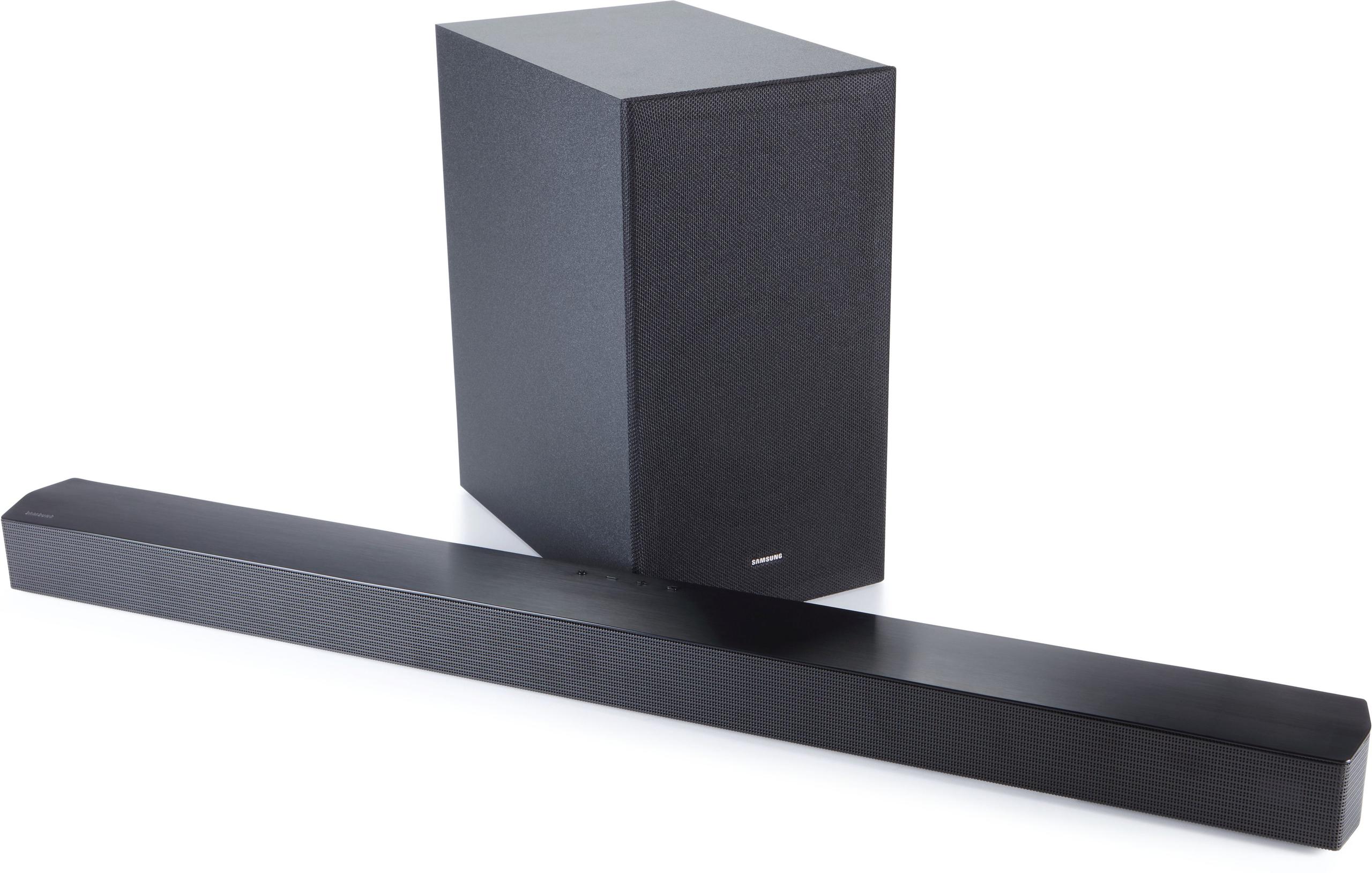 Samsung HW-B550D 3.1 Channel Sound Bar
Samsung HW-B550D 3.1 Channel Sound Bar

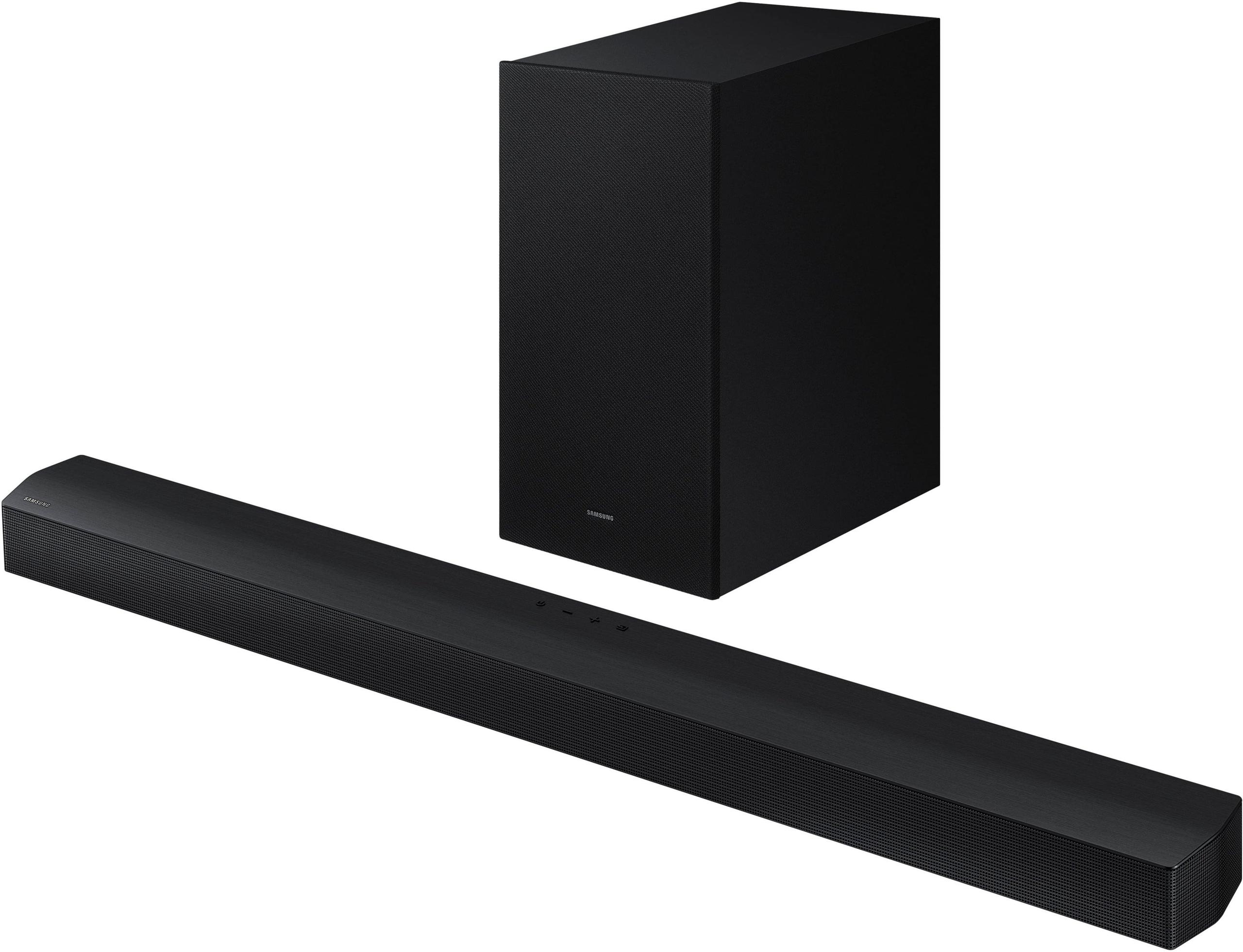
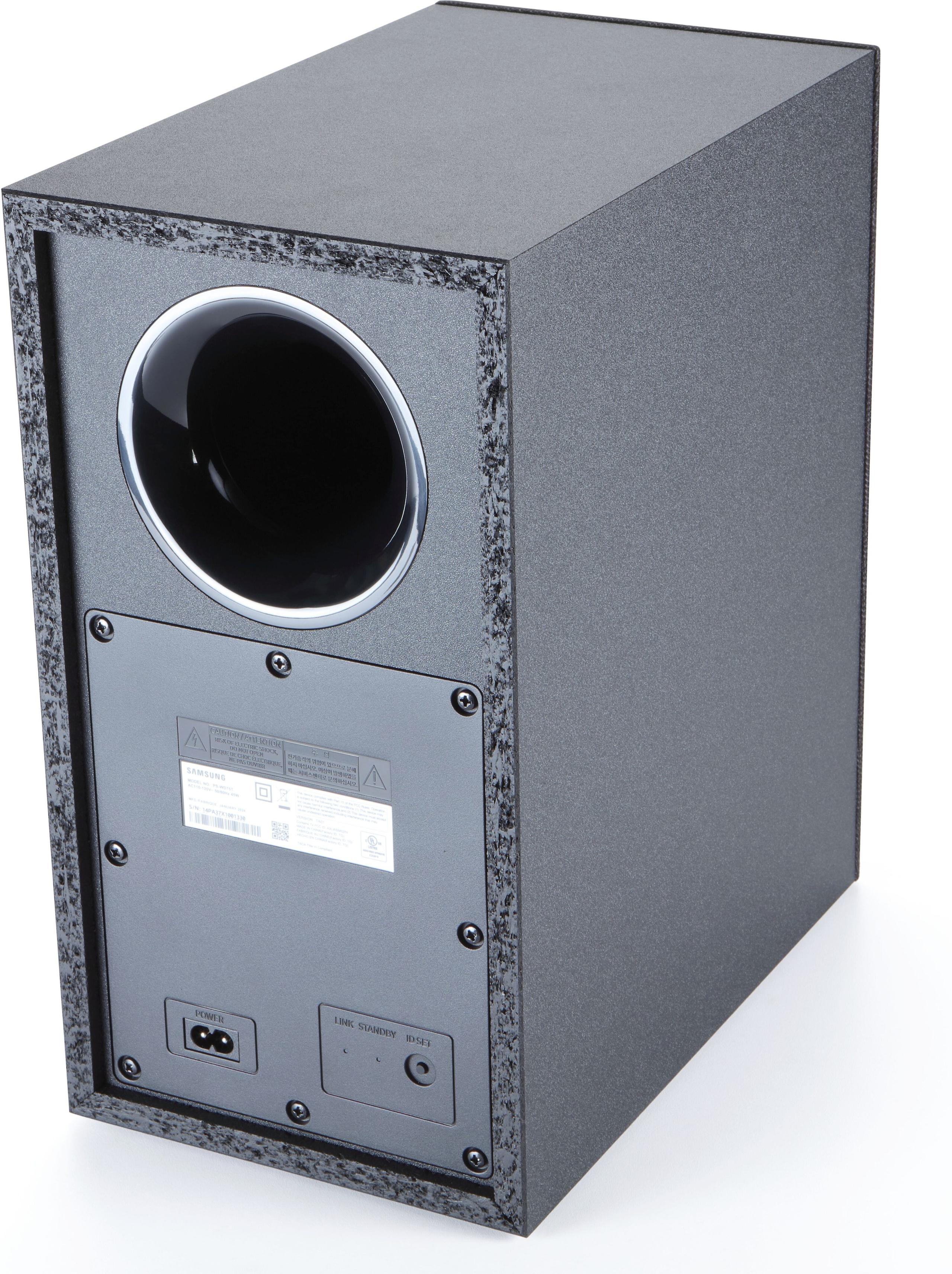
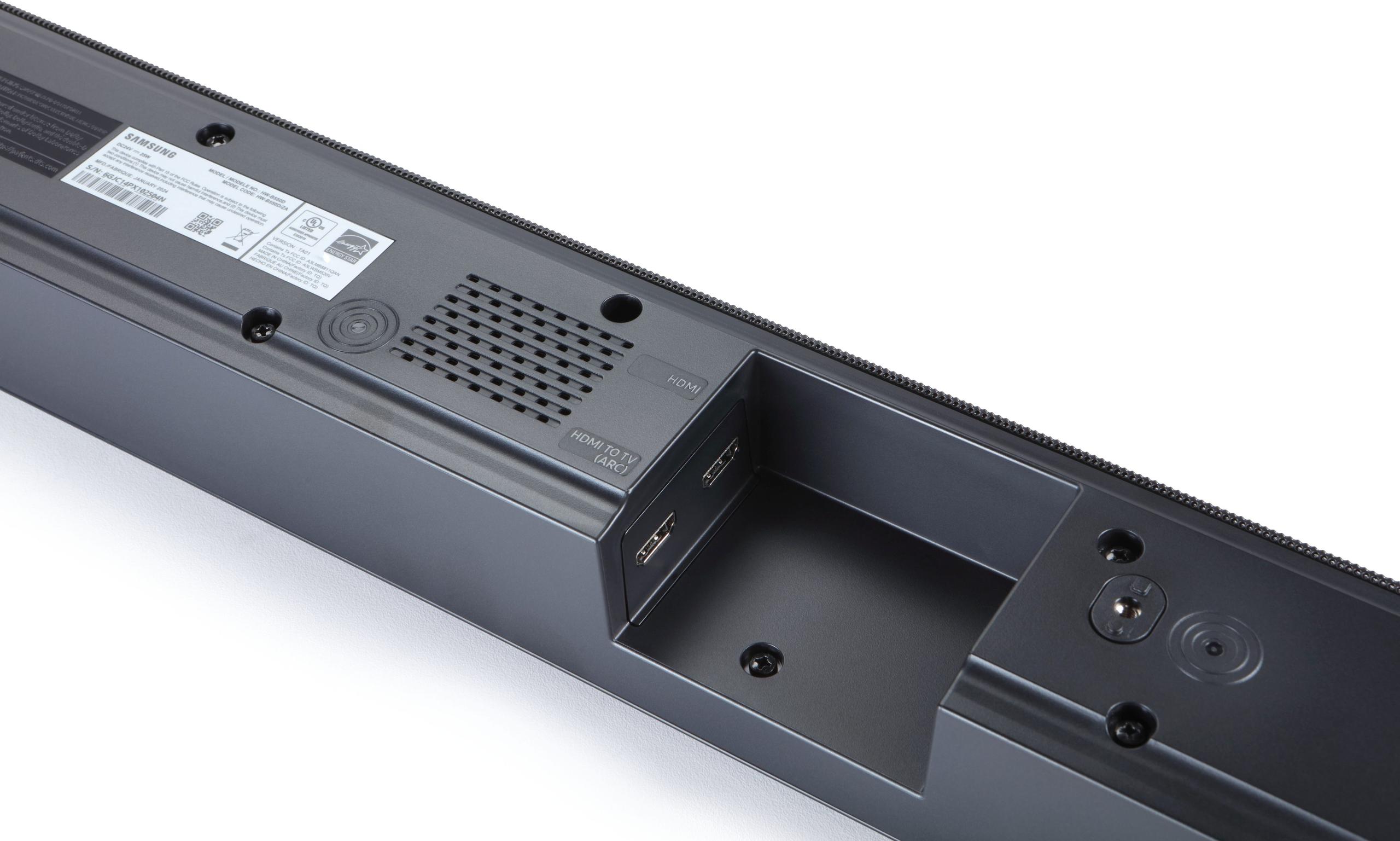
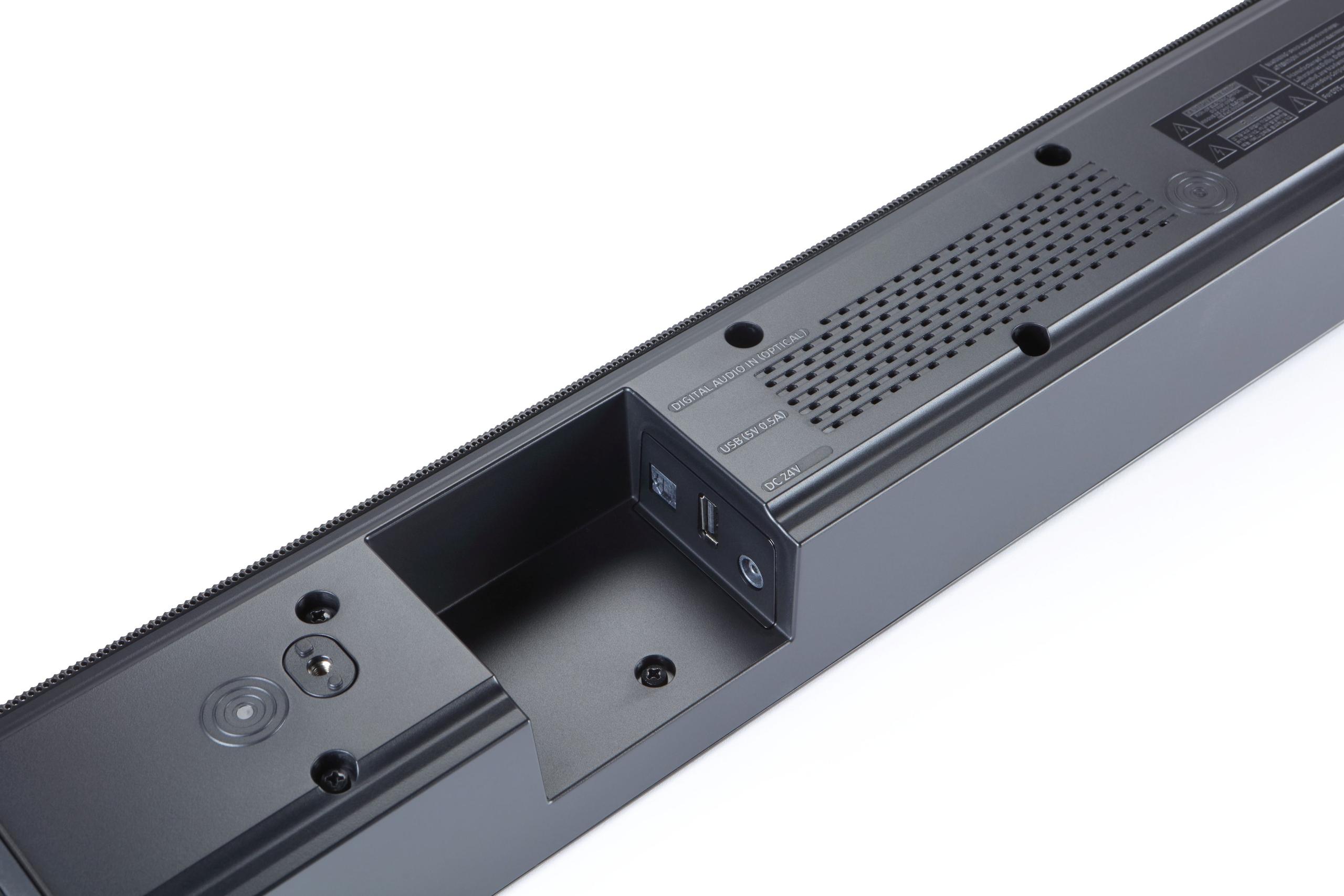

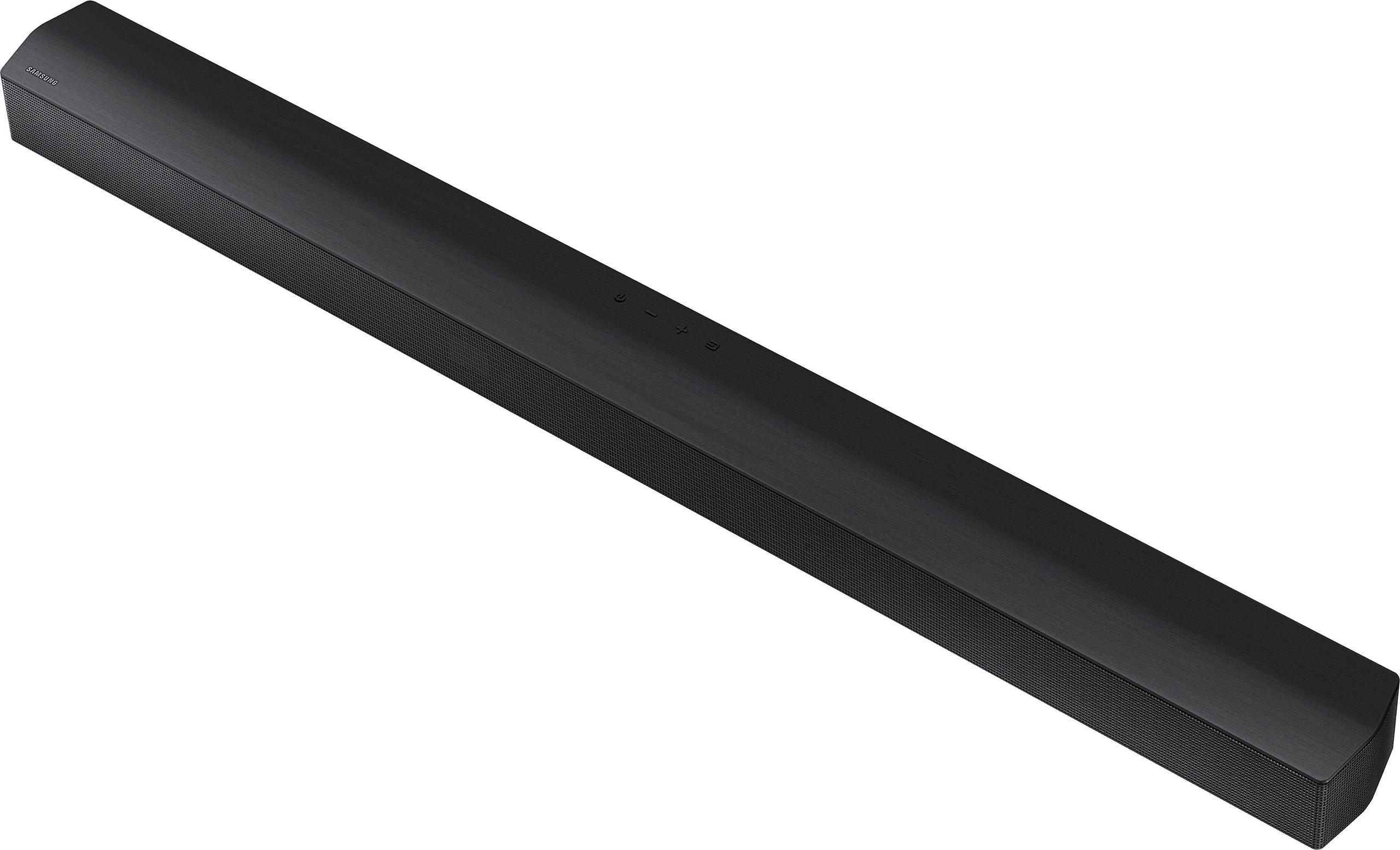

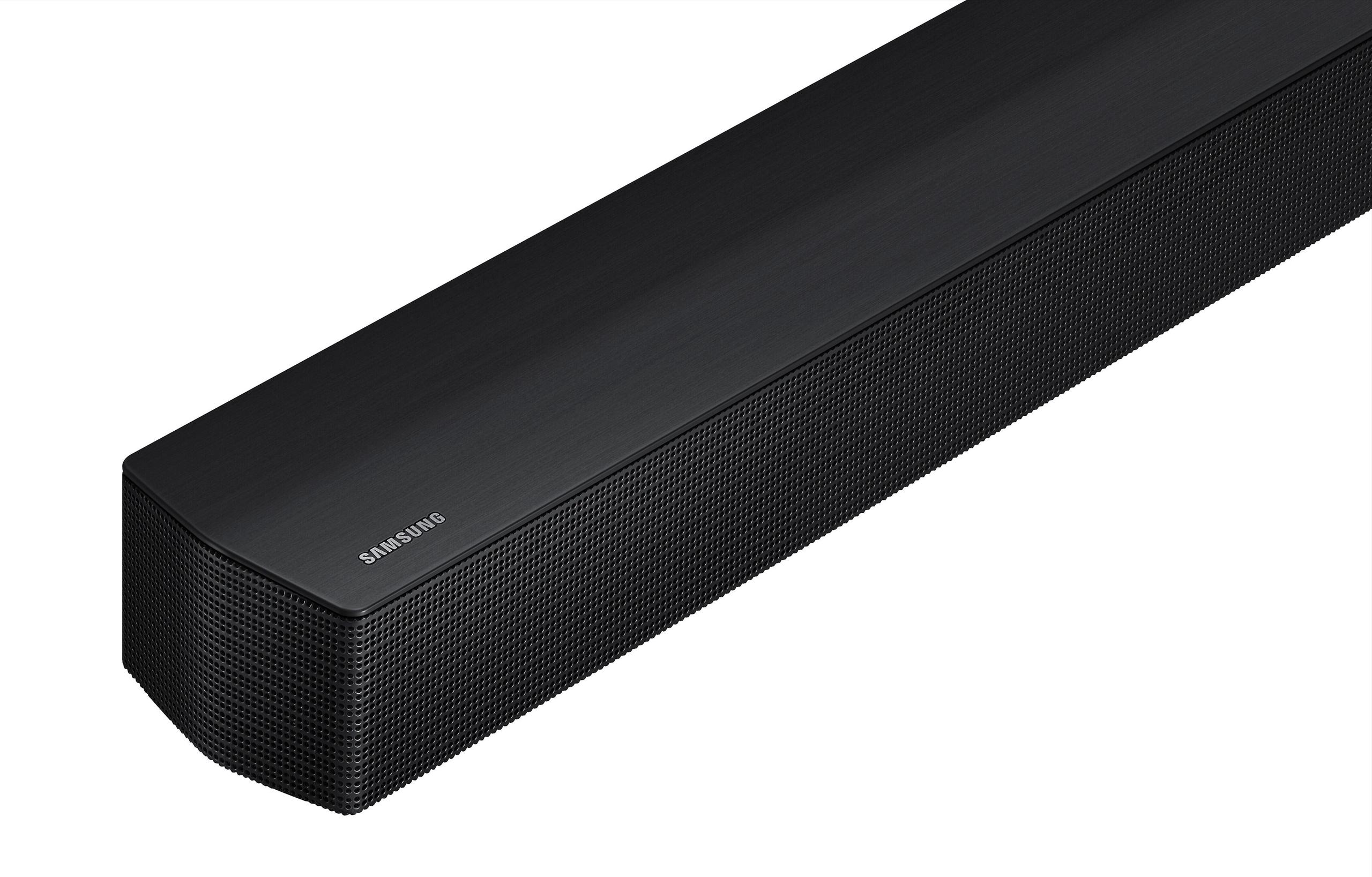


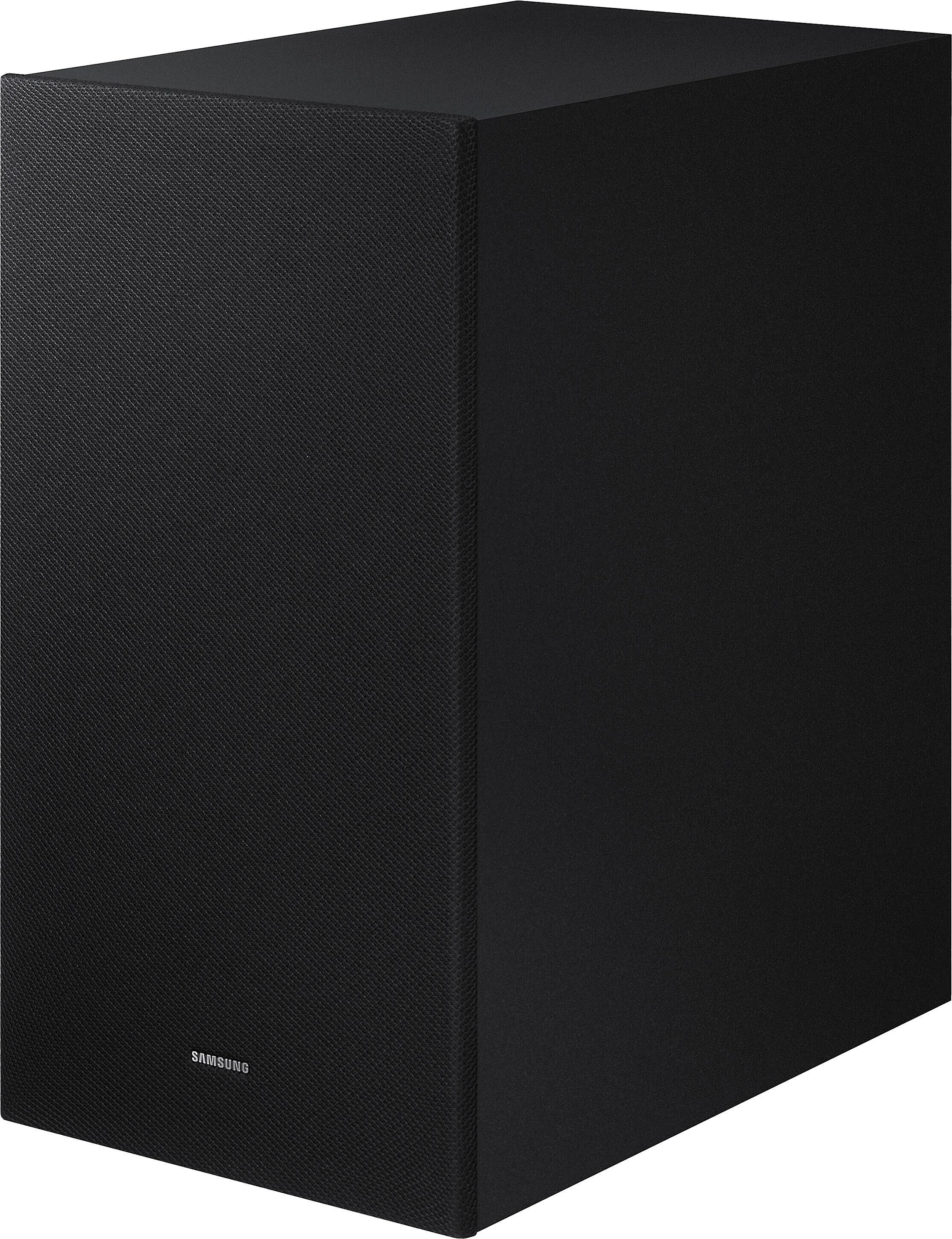












$299.99 Original price was: $299.99.$217.99Current price is: $217.99.
The Samsung HW-B550D entered the market in mid-2023, bringing several meaningful improvements to Samsung's mid-range soundbar lineup. After spending considerable time testing this system across various content types, it's clear this 3.1 channel soundbar offers impressive value at its $279 price point.
The soundbar market has evolved significantly since 2020, with virtual surround technology and dialogue enhancement becoming must-have features rather than premium additions. The HW-B550D represents this shift well, incorporating technologies that were once reserved for higher-end models.
In our testing, the 340W total power output proved more than adequate for medium-sized rooms. The dedicated center channel - a feature often missing in this price range - delivers noticeably clearer dialogue compared to 2.0 or 2.1 systems. This means you won't be constantly adjusting volume during movies when scenes shift from quiet conversations to action sequences.
The wireless subwoofer, featuring a 5-inch driver, provides surprisingly punchy bass. While it won't shake your foundations like some premium systems, it adds satisfying weight to explosions and music without overwhelming the mix. We found placing it in a corner about 6-8 feet from the main viewing position worked best.
DTS Virtual:X technology creates a convincing illusion of surround sound without requiring additional speakers. While testing action movies like "Mad Max: Fury Road," the virtual height channels were particularly noticeable during overhead scenes. It's not quite as immersive as a true Dolby Atmos setup, but it's remarkably effective for the price point.
The Adaptive Sound Lite feature continuously analyzes content and adjusts audio settings accordingly. During our testing, this worked particularly well when switching between news broadcasts and movies - dialogue remained clear while action scenes still packed a punch.
The HW-B550D offers modern connectivity while maintaining compatibility with older devices:
The inclusion of HDMI ARC is particularly valuable, allowing TV remote control of the soundbar's basic functions - a convenience that shouldn't be underestimated in daily use.
In a dedicated home theater setting, the HW-B550D performs admirably for its class. The Surround Sound Expansion feature creates a wider soundstage that works especially well in rooms with walls on both sides. During our movie sessions, we noticed:
For rooms up to 400 square feet, this system provides more than enough power while maintaining audio quality. Larger spaces might benefit from a more powerful system, but for most home theaters, this hits a sweet spot of performance and value.
After extensive testing across different content types, here's how the system performed:
The center channel shines here, making dialogue clear and natural. Action scenes benefit from the subwoofer's impact without losing detail in the mix. The virtual surround creates a satisfying bubble of sound that enhances the viewing experience.
While primarily designed for TV audio, music playback is surprisingly good. The system handles different genres well, though bass-heavy music can sometimes sound a bit boomy unless the subwoofer level is adjusted.
The dedicated Game Mode reduces audio lag and emphasizes positional audio cues. While not as precise as a full surround setup, it provides good directional awareness for casual gaming.
Installation is straightforward: the main bar can be wall-mounted or placed on a TV stand, while the wireless subwoofer only needs power and can be positioned flexibly within about 30 feet of the main unit. The auto-pairing feature worked flawlessly in our testing.
At $279, the HW-B550D competes effectively with similarly priced options from Vizio and LG. The inclusion of features like:
Makes it a compelling choice for those wanting quality audio without breaking into premium pricing tiers.
The Samsung HW-B550D represents a sweet spot in the current soundbar market. It delivers features that matter most for everyday use while skipping costly extras that many users might never utilize. The sound quality punches above its price point, especially for dialogue clarity and virtual surround effects.
While it lacks premium features like Dolby Atmos or Wi-Fi connectivity, it nails the fundamentals that most users care about: clear dialogue, impactful bass, and easy setup. For anyone looking to significantly upgrade their TV audio without entering the premium price territory, this system deserves serious consideration.
The HW-B550D continues to impress with its balance of performance, features, and value, making it a solid recommendation for most users looking to upgrade their TV audio experience.
The Samsung HW-B550D offers excellent value at its price point. With features like a dedicated center channel, wireless subwoofer, and DTS Virtual:X, it delivers impressive performance for home theater use. While it lacks premium features like Dolby Atmos, its clear dialogue reproduction and virtual surround capabilities make it worth the investment for most users looking to upgrade their TV audio.
The Samsung HW-B550D performs very well with movies, thanks to its 3.1 channel configuration. The dedicated center channel ensures clear dialogue, while the wireless subwoofer adds impact to action scenes. DTS Virtual:X technology creates an immersive surround effect that enhances the movie-watching experience.
Yes, the soundbar can connect wirelessly to compatible Samsung TVs via Bluetooth. For other TVs, you can use either HDMI ARC or optical connection for the best audio quality, or Bluetooth if available on your TV.
With 340W of total power output, the Samsung HW-B550D is ideal for small to medium-sized rooms up to 400 square feet. It provides sufficient volume and coverage for typical living rooms and home theater spaces without distortion.
Yes, the soundbar includes a dedicated Game Mode that reduces audio lag and emphasizes directional sound cues. While not as precise as a full surround system, it provides good positional audio awareness for casual gaming sessions.
Setup is very straightforward. The soundbar connects to your TV via HDMI ARC or optical cable, and the wireless subwoofer pairs automatically. No complex calibration is required, though you can adjust bass and treble levels to your preference.
Yes, the Samsung HW-B550D can be wall-mounted, and mounting brackets are included in the package. The slim design (2.3 inches high) works well for wall mounting under most TVs.
The soundbar performs well with music, offering clear stereo separation and good bass response through the wireless subwoofer. While not primarily designed for music, it handles various genres competently and includes a dedicated Music Mode.
No, the Samsung HW-B550D doesn't support Dolby Atmos. However, it does feature DTS Virtual:X, which creates virtual surround effects including height channels for an immersive listening experience.
The soundbar features HDMI ARC, optical input, USB port, and Bluetooth connectivity. This provides flexible connection options for both modern and older devices. The HDMI ARC connection allows for easy control using your TV remote.
We've done our best to create useful and informative comparisons to help you decide what product to buy. Our research has used advanced automated methods to create this comparison and perfection is not possible - please contact us for corrections or questions. These are the sites we've researched in the creation of this article: bestbuy.com - crutchfield.com - avsforum.com - consumerreports.org - abt.com - pcrichard.com - samsung.com - samsung.com - rtings.com - samsung.com - jeffsappliance.com
| Samsung HW-B550D 3.1 Channel Sound Bar |
|---|
| Channel Configuration - Determines speaker layout and surround capability: 3.1 channels |
| Total Power Output - Impacts maximum volume and room size compatibility: 340W |
| Center Channel - Dedicated speaker for clear dialogue: Yes |
| Virtual Surround Technology - Creates immersive sound without rear speakers: DTS Virtual:X |
| Subwoofer Size - Affects bass performance: 5-inch driver |
| Wireless Subwoofer Range - Maximum distance from soundbar: 30 feet |
| HDMI Inputs - For connecting external devices: 1 |
| HDMI ARC - Enables TV audio and control through single cable: Yes |
| Audio Formats - Supported sound processing: Dolby Digital, DTS Digital Surround |
| Bluetooth Version - For wireless streaming quality: 5.0 |
| Sound Modes - Preset audio configurations: Standard, Surround, Game, Adaptive Sound Lite |
| Voice Enhancement - Boosts dialogue clarity: Yes |
| Night Mode - Reduces volume peaks for quiet listening: Yes |
| Soundbar Dimensions: 33.9" × 2.3" × 3.0" |
| Subwoofer Dimensions: 13.5" × 7.3" × 13.1" |
| System Weight - Combined soundbar and subwoofer: 15.6 lbs |
The Samsung B-Series 5.1 Channel Soundbar ($277.99) takes immersion to the next level with its dedicated rear speakers, creating true surround sound that places you in the middle of the action. While it commands a $100 premium over the HW-B550D, this investment delivers tangible benefits for movie enthusiasts and gamers - you'll actually hear sounds moving behind you, whether it's a car chase in an action film or footsteps in a first-person shooter. The additional speakers also create a wider, more engaging soundstage that fills larger rooms more effectively than virtual surround solutions.
However, these advantages come with practical considerations. The 5.1 system requires more complex setup, including finding spots for rear speakers and managing power cables. For many users, especially those in smaller spaces or apartments, the extra cost and setup complexity of the B-Series 5.1 might not justify the performance gains. The true surround sound experience is impressive when properly set up, but if you're primarily watching TV shows and casual content, or if your room layout doesn't accommodate rear speakers well, the simpler 3.1 solution might be the smarter choice.
🤖 Read Detailed Comparison
👌Samsung B-Series 5.1 Channel Soundbar with Subwoofer Details
💵 See Samsung B-Series 5.1 Channel Soundbar with Subwoofer Price
The Samsung HW-Q990D ($1,800) operates in an entirely different league with its 11.1.4 channel configuration, featuring 22 total speakers that create a true dome of sound around your listening position. While our reviewed B550D handles basic TV audio well, the Q990D adds precise sound placement through Dolby Atmos support, SpaceFit Sound Pro room calibration, and dedicated up-firing speakers for height effects. This premium model also includes advanced gaming features like 4K/120Hz pass-through and VRR support, plus modern conveniences such as voice assistant integration and Apple AirPlay 2.
The question of whether the Q990D's premium price is worth nearly ten times the cost of the B550D depends entirely on your priorities and setup. For dedicated home theater spaces or serious gaming setups, the Q990D's immersive surround sound and advanced features deliver a genuinely theatrical experience that the B550D simply can't match. However, for smaller rooms or primarily casual TV viewing, the Q990D's sophisticated capabilities might be overkill, and the extra investment may not translate to proportionally better real-world enjoyment.
🤖 Read Detailed Comparison
👌Samsung HW-Q990D 11.1.4 Channel Sound Bar Details
💵 See Samsung HW-Q990D 11.1.4 Channel Sound Bar Price
The Samsung HW-S700D ($397.99) stands apart from the B550D primarily through its Dolby Atmos support, ultra-slim design, and advanced room calibration features. The SpaceFit Sound Pro technology makes a noticeable difference in real-world listening, automatically adjusting the sound profile to your specific room characteristics. For Samsung TV owners, the Q-Symphony feature creates a more cohesive soundstage by synchronizing the TV speakers with the soundbar, while the slim 39.9mm profile makes it particularly suited for wall-mounted setups. The larger 6-inch subwoofer and increased 480W power output also provide more impactful bass and better performance in larger spaces.
While these premium features of the HW-S700D are impressive, they come at a $220 price premium over the B550D. The improved audio processing and smart features like AirPlay, Chromecast, and voice assistant support will appeal to tech-savvy users who want deeper integration with their home entertainment system. The ability to add wireless rear speakers later also provides valuable future-proofing. However, for many users, these enhancements may not justify the significant price increase, especially if they don't have a Samsung TV or aren't specifically seeking Dolby Atmos capability.
🤖 Read Detailed Comparison
👌Samsung HW-S700D 3.1 Channel Slim Soundbar Details
💵 See Samsung HW-S700D 3.1 Channel Slim Soundbar Price
The Sony HT-A8000 offers significantly more advanced features and superior sound quality, though at $698 it costs nearly four times as much. Its 7.1.2 channel configuration with upfiring speakers delivers true Dolby Atmos performance, creating a genuine dome of sound that the Samsung can't match. The Sony's 360 Spatial Sound Mapping technology and advanced room calibration ensure optimal sound quality regardless of room layout, while its HDMI 2.1 connectivity provides future-proofing for the latest gaming consoles and 8K content.
For home theater enthusiasts with larger rooms or those seeking premium audio performance, the Sony HT-A8000 justifies its higher price tag through noticeably better sound staging, more powerful output, and the ability to expand the system with wireless rear speakers. However, its advanced features and higher price point may be overkill for users with smaller spaces or those primarily watching regular TV programming, where the Samsung's more modest capabilities remain perfectly adequate.
🤖 Read Detailed Comparison
👌Sony HT-A8000 BRAVIA Theater Bar 8 Soundbar Details
💵 See Sony HT-A8000 BRAVIA Theater Bar 8 Soundbar Price
The Samsung HW-Q800D ($697.99) represents a significant step up in both features and performance, offering true Dolby Atmos support through its 5.1.2 channel configuration with dedicated upward-firing speakers. Where the B550D provides basic surround simulation, the Q800D creates genuine three-dimensional sound with precise spatial positioning and overhead effects. The addition of SpaceFit Sound Pro room correction technology, along with its more powerful 8-inch subwoofer and advanced processing capabilities, delivers a notably more immersive experience for both movies and music. The Q800D also benefits from better connectivity options, including eARC support and an additional HDMI input, plus integration with Samsung's SmartThings ecosystem.
While the price difference is substantial, the Q800D justifies its premium positioning through tangible performance benefits that become apparent in daily use. The larger soundstage, more precise imaging, and significantly more powerful output make it better suited for medium to large rooms where the B550D might struggle to fill the space. For dedicated home theater enthusiasts or those planning to build their system over time, the Q800D offers valuable expandability through optional wireless rear speakers. However, if you're primarily watching regular TV content in a smaller room and don't need Dolby Atmos support, the extra investment might not be necessary for your needs.
🤖 Read Detailed Comparison
👌Samsung HW-Q800D 5.1.2 Channel Soundbar Details
💵 See Samsung HW-Q800D 5.1.2 Channel Soundbar Price
The Bose Solo Series 2 takes a notably different approach, focusing on simplicity and compact design over feature-rich audio processing. Its standout characteristics include an incredibly straightforward setup process and a smaller footprint that works particularly well in bedrooms or smaller living spaces. While it lacks a separate subwoofer, Bose's audio engineering delivers surprisingly clear dialogue and balanced sound from a single, slim unit. The dedicated dialogue enhancement mode is especially effective for improving TV show and news program clarity, which some users might actually prefer over the Samsung's more complex audio processing.
However, the Bose Solo Series 2 makes some clear compromises to achieve its simplicity and compact size. The absence of a subwoofer means significantly less bass impact, and the 2.0 channel configuration can't match the Samsung's more immersive soundstage. While both units are similarly priced, the Bose represents better value for those prioritizing ease of use and space efficiency over audio performance. It's best suited for viewers who primarily watch regular TV programming and want clearer dialogue without the complexity of additional speakers or advanced sound modes.
🤖 Read Detailed Comparison
👌Bose Solo Soundbar Series 2 Soundbar Details
💵 See Bose Solo Soundbar Series 2 Soundbar Price
The Klipsch Flexus Core 100 takes a more premium approach at $349.99, featuring an innovative all-in-one design with dual 4-inch built-in subwoofers that eliminate the need for a separate bass unit. This integrated solution delivers surprisingly powerful and precise bass, particularly excelling with music playback. The soundbar's build quality is notably superior, utilizing premium materials like wooden MDF enclosure and metal accents, which contribute to both better acoustics and longevity. Its more compact single-unit design might better suit those with space constraints or who prefer a cleaner aesthetic.
However, the higher price point of the Klipsch Flexus Core 100 raises the question of value, especially for users primarily watching TV and movies. While it offers sophisticated features like Dolby Atmos processing and future expandability with wireless surrounds and subwoofer options, these advantages may not justify the nearly $170 premium for many users. The lack of a dedicated center channel means dialogue clarity, while good, doesn't quite match the Samsung's performance in this crucial area. The Klipsch system makes more sense for those who prioritize music listening, care about build quality, or want the flexibility to expand their system later.
🤖 Read Detailed Comparison
👌Klipsch Flexus Core 100 Soundbar Details
💵 See Klipsch Flexus Core 100 Soundbar Price
The Klipsch Flexus Core 200 represents a significant step up in both features and performance, though at $499.99, it comes at a premium price point. Its standout features include true Dolby Atmos support with dedicated up-firing speakers, dual built-in 4-inch subwoofers that deliver surprisingly deep and controlled bass, and Klipsch's signature horn-loaded tweeter for exceptional dialogue clarity. The integrated subwoofer design is particularly appealing for apartment dwellers who want powerful bass without disturbing neighbors, while the 185W RMS power rating ensures it can fill larger rooms with dynamic sound.
Where the Klipsch Flexus Core 200 really differentiates itself is in its expandability and premium audio performance. The ability to add wireless surrounds and additional subwoofers makes it more future-proof, while its superior processing and driver design deliver noticeably better performance with both movies and music. The 44-inch width creates a wider soundstage that pairs well with larger TVs, and the eARC support ensures compatibility with the latest high-quality audio formats. While these features may be overkill for casual viewers, they make a meaningful difference for home theater enthusiasts or anyone seeking a more immersive audio experience.
🤖 Read Detailed Comparison
👌Klipsch Flexus Core 200 3.1.2 Soundbar Details
💵 See Klipsch Flexus Core 200 3.1.2 Soundbar Price
The Sony BRAVIA Theater Bar 9 ($1,400) represents a significant step up in sound technology, featuring a sophisticated 13-speaker array that creates genuine surround sound with overhead effects. Its 360° Spatial Sound Mapping technology uses advanced processing to create phantom speakers throughout the room, delivering a more convincing home theater experience than the HW-B550D's virtual surround. The addition of features like Voice Zoom 3, room calibration, and support for high-resolution audio formats makes it a more capable system for discerning listeners, particularly in larger rooms where its acoustic benefits can truly shine.
However, the premium features of the Sony BRAVIA Theater Bar 9 come at a considerable cost premium that may be hard to justify for many users. While it does offer superior sound staging, more precise audio positioning, and better integration with streaming services through WiFi and AirPlay 2, these advantages might not be worth the eight-fold price increase for casual viewers. The lack of an included subwoofer also means additional investment is needed for optimal bass performance. For dedicated home theater enthusiasts or those with larger spaces where the advanced spatial audio features can be fully appreciated, the BRAVIA Bar 9's premium performance might justify its price, but most users will find the HW-B550D's value proposition more compelling.
🤖 Read Detailed Comparison
👌Sony BRAVIA Theater Bar 9 Soundbar Details
💵 See Sony BRAVIA Theater Bar 9 Soundbar Price
The $999 Sonos Arc Ultra operates in a completely different league, offering a premium home theater experience with its 9.1.4 channel configuration and advanced Dolby Atmos support. Its array of 14 precisely-tuned drivers creates a genuinely immersive soundstage that extends not just wider but also higher than the Samsung, producing convincing overhead effects for compatible content. The Sonos also delivers superior music performance, with clearer separation between instruments and vocals, plus the ability to integrate seamlessly into a whole-home audio system.
While the price difference is substantial, the Sonos justifies its premium positioning with features like TruePlay room calibration, regular software updates, and the ability to expand the system over time with additional Sonos speakers or a subwoofer. However, it's worth noting that the $999 Sonos Arc Ultra doesn't include a subwoofer, which means you'll need to spend significantly more to match the Samsung's bass capabilities out of the box. For those seeking the absolute best in sound quality and willing to invest in their home theater setup, the Sonos represents the more future-proof choice, though its premium features may be overkill for casual TV viewers.
🤖 Read Detailed Comparison
👌Sonos Arc Ultra Dolby Atmos Soundbar Details
💵 See Sonos Arc Ultra Dolby Atmos Soundbar Price
The LG S95TR ($999) takes a significantly different approach with its premium 9.1.5 channel configuration, offering true Dolby Atmos support through dedicated up-firing speakers and wireless rear surrounds. This creates a more immersive sound bubble that extends above and behind the listening position - something the HW-B550D can't replicate with its virtual processing. The S95TR also includes advanced features like room calibration, Wi-Fi streaming, and voice assistant support, making it more suitable for dedicated home theater setups in larger rooms.
However, the S95TR's considerable price premium may be hard to justify for many users, especially considering the HW-B550D delivers strong performance for basic TV and movie watching. While the S95TR offers superior technical capabilities, its complex setup and higher price point make it a better fit for enthusiasts who will fully utilize its advanced features. For most users watching regular content in medium-sized rooms, the extra investment might not translate to proportionally better real-world enjoyment.
🤖 Read Detailed Comparison
👌LG S95TR 9.1.5 Channel Soundbar with Dolby Atmos Soundbar Details
💵 See LG S95TR 9.1.5 Channel Soundbar with Dolby Atmos Soundbar Price
The LG S90TR ($799.99) operates in an entirely different league with its premium 7.1.3 channel configuration and true Dolby Atmos support. While it commands a significantly higher price, it delivers genuinely immersive surround sound through dedicated rear speakers and upfiring drivers that create overhead effects. The AI room calibration automatically optimizes sound for your specific space, and the larger subwoofer provides deeper, more controlled bass that integrates seamlessly with the overall system. When watching movies or gaming, the difference is immediately noticeable - sounds truly move around and above you, rather than being simulated from the front.
However, the premium features of the S90TR may be overkill for casual TV watching or smaller rooms. Its advanced capabilities shine in dedicated home theater spaces or larger rooms where the additional speakers and processing power can properly create an enveloping soundstage. While the LG S90TR offers substantially better audio performance and more future-proof features like Dolby Atmos and DTS:X support, buyers should carefully consider if their room size and viewing habits justify the significant price premium over the more basic Samsung offering.
🤖 Read Detailed Comparison
👌LG S90TR 7.1.3 Channel Soundbar with Wireless Subwoofer and Rear Speakers - Soundbar Details
💵 See LG S90TR 7.1.3 Channel Soundbar with Wireless Subwoofer and Rear Speakers - Soundbar Price
The JBL Bar 1000 represents a significant step up in home theater capability, offering a premium 7.1.4 channel experience with true Dolby Atmos support at $1,139.95. Its standout feature is the pair of detachable wireless rear speakers with up-firing drivers, creating genuine surround sound and overhead effects that the Samsung simply cannot match. The system's 880W of total power output, driven by a substantial 10-inch wireless subwoofer, delivers room-filling sound with impressive dynamic range. For movies and games, this translates to a notably more immersive experience, with effects that genuinely seem to move around and above the listening position.
While the JBL Bar 1000 commands a significantly higher price, it justifies the premium for serious home theater enthusiasts with additional features like built-in Wi-Fi, AirPlay, and Chromecast support, along with automatic room calibration. The PureVoice dialogue enhancement technology provides clearer voice reproduction than standard center channel processing, while the MultiBeam surround technology creates a more convincing three-dimensional soundstage. For larger rooms and dedicated viewing spaces, the JBL's superior power handling and genuine surround capabilities make it a more future-proof investment, though its benefits may be less noticeable in smaller spaces or for casual viewing.
🤖 Read Detailed Comparison
👌JBL Bar 1000 Surround Sound System with 7.1.4 Channel Soundbar, 10" Wireless Subwoofer, Detachable Rear Speakers, and Dolby Atmo Details
💵 See JBL Bar 1000 Surround Sound System with 7.1.4 Channel Soundbar, 10" Wireless Subwoofer, Detachable Rear Speakers, and Dolby Atmo Price
The Bose TV Speaker takes a markedly different approach with its streamlined, single-unit design. At $147, it's $31 less expensive and focuses on delivering exceptional dialogue clarity through Bose's advanced audio processing rather than using a dedicated center channel. Its compact 23.4-inch width makes it an ideal solution for smaller spaces or situations where a subwoofer isn't practical, such as apartments with thin walls or bedrooms. The emphasis on simplicity extends to its setup and operation, with just two sound modes and straightforward controls that many users find less intimidating.
Where the Bose particularly excels is in its ability to deliver surprisingly full sound from a single compact unit. While it can't match the Samsung's bass impact or surround capabilities, the Bose TV Speaker produces remarkably clear, balanced audio that significantly improves upon built-in TV speakers. For users prioritizing dialogue clarity and simplicity over cinematic impact, or those with space constraints, the Bose offers a compelling alternative. Its minimalist approach to both design and features means there's less to configure and maintain, making it an excellent choice for users who want better TV sound without the complexity of multiple components or sound modes.
🤖 Read Detailed Comparison
👌Bose TV Speaker Soundbar Details
💵 See Bose TV Speaker Soundbar Price
The Yamaha SR-B40A represents a step up in audio performance at $399.95, particularly notable for its superior bass response from its larger 6.25-inch subwoofer and more sophisticated sound processing. While it doesn't have a dedicated center channel, its Clear Voice technology and Dolby Atmos simulation create an impressively immersive soundstage that works especially well in larger rooms. Music playback is where this soundbar truly differentiates itself, offering better instrument separation, more detailed highs, and significantly more controlled bass response across all volume levels.
However, the premium features of the Yamaha SR-B40A come at more than twice the price of the Samsung. The Yamaha's more powerful 320W system and larger subwoofer might actually be overkill for apartment dwellers or smaller rooms, though they're ideal for serious home theater enthusiasts with larger spaces. Its comprehensive app control and additional sound customization options provide more fine-tuning possibilities, but many users may not need this level of adjustment. While it delivers superior audio quality overall, the value proposition becomes harder to justify unless you're specifically looking for better music performance or need to fill a larger space with sound.
🤖 Read Detailed Comparison
👌Yamaha SR-B40A 2.1-Channel Sound Bar with Wireless Subwoofer Details
💵 See Yamaha SR-B40A 2.1-Channel Sound Bar with Wireless Subwoofer Price
The Yamaha SR-B30A ($279.95) takes an innovative approach with its all-in-one design featuring built-in dual subwoofers. This integrated solution delivers surprisingly robust bass for its compact size, though not quite matching the depth and impact of the Samsung's separate subwoofer. Where the Yamaha really shines is in its support for Dolby Atmos, creating a more immersive sound field that extends above the listening position. Its slim profile and single-unit design make it particularly appealing for smaller spaces or wall-mounting applications, while the comprehensive app control offers more refined sound customization options.
While it commands a higher price point, the Yamaha SR-B30A justifies the premium through its modern feature set and simpler setup process. The inclusion of Clear Voice technology provides good dialogue clarity despite lacking a dedicated center channel, and its four distinct sound modes (including specific options for movies and gaming) offer versatility for different content types. It's especially well-suited for apartments or smaller rooms where space is at a premium, and for users who stream a lot of modern content with Dolby Atmos support from services like Netflix and Disney+.
🤖 Read Detailed Comparison
👌Yamaha SR-B30A Sound Bar with Built-In Subwoofers Details
💵 See Yamaha SR-B30A Sound Bar with Built-In Subwoofers Price
The JBL Bar 700 ($899) represents a significant step up in home theater capability, offering true 5.1 surround sound with detachable wireless rear speakers and Dolby Atmos support. Its larger 10-inch subwoofer delivers noticeably deeper and more impactful bass, while the PureVoice technology provides superior dialogue clarity during complex action scenes. The addition of Wi-Fi connectivity enables high-quality streaming through AirPlay and Chromecast, while eARC support and 4K Dolby Vision pass-through ensure compatibility with the latest TV technologies. The automatic room calibration feature also helps optimize sound for your specific space, something particularly valuable in larger rooms.
While the price difference is substantial, the JBL Bar 700 justifies its premium positioning through measurably better performance and more extensive features. The physical rear speakers create a truly immersive surround experience that virtual processing can't match, while the Dolby Atmos implementation adds a height dimension to the soundstage that transforms movies and games. For dedicated home theater enthusiasts or those with larger rooms who want to maximize their audio experience, the JBL's additional investment delivers tangible benefits. However, these advantages are most noticeable when watching movies and high-quality content in a properly set up room where the system can showcase its full capabilities.
🤖 Read Detailed Comparison
👌JBL Bar 700 Dolby Atmos 5.1 Soundbar with Subwoofer Details
💵 See JBL Bar 700 Dolby Atmos 5.1 Soundbar with Subwoofer Price
The Sony HT-A3000 represents a significant step up in both features and performance, though at $498 it costs nearly three times as much as the Samsung. The Sony's standout features include true Dolby Atmos support, sophisticated Sound Field Optimization, and built-in dual subwoofers. Its advanced audio processing creates a more convincing surround sound experience, with better placement of individual sounds and a more expansive soundstage. The addition of features like 360 Reality Audio and DSEE Extreme upscaling make it particularly appealing for music lovers, while its room optimization technology helps deliver consistent performance regardless of room layout.
Where the Sony really shines is in creating a more premium home theater experience. The Sony HT-A3000 handles complex movie soundtracks with greater clarity and precision, offering superior dialogue intelligence and more impactful bass response. Its expandability options for adding rear speakers make it more future-proof, and features like Wi-Fi streaming and voice assistant compatibility provide additional value. While the higher price point puts it in a different category than the Samsung, the performance improvements are noticeable enough to justify the cost for users who prioritize audio quality and want a more theater-like experience from their soundbar.
🤖 Read Detailed Comparison
👌Sony HT-A3000 3.1ch Dolby Atmos Soundbar Details
💵 See Sony HT-A3000 3.1ch Dolby Atmos Soundbar Price
The JBL Bar 300 5.0 ($349.95) takes a more sophisticated approach with its all-in-one design and advanced digital processing capabilities. Instead of a separate subwoofer, it uses innovative MultiBeam technology and built-in bass radiators to create surprisingly powerful low frequencies from a single unit. The inclusion of Dolby Atmos support, along with Wi-Fi connectivity enabling AirPlay, Chromecast, and voice assistant compatibility, makes it a more versatile smart home entertainment solution. The automatic room calibration feature helps optimize sound for your specific space, though you'll pay nearly twice as much for these advanced features.
While the JBL can't match the raw bass impact of the Samsung's dedicated subwoofer, it offers superior surround sound processing and a more refined overall audio presentation. The JBL Bar 300 particularly shines in apartments or smaller rooms where space is at a premium, and its streaming capabilities make it an excellent choice for users who frequently listen to music through various services. The more compact single-unit design and smart features future-proof your investment, though the higher price point may be harder to justify if you're primarily focused on basic TV and movie sound enhancement rather than the additional smart functionality.
🤖 Read Detailed Comparison
👌JBL Bar 300 5.0 Soundbar Details
💵 See JBL Bar 300 5.0 Soundbar Price
The Sonos Arc represents a significant step up in both features and audio sophistication, though at $564 it commands a premium price point. Its standout Dolby Atmos implementation, using upward-firing speakers, creates a genuinely immersive soundstage that extends both above and around the listening position. The Arc's smart features, including built-in voice assistants and AirPlay 2 support, transform it into a versatile home entertainment hub rather than just a TV sound solution. The sophisticated audio processing and room correction technology deliver notably refined sound quality, particularly evident in music playback and complex movie soundtracks.
However, the Sonos Arc requires additional investment to match the HW-B550D's bass impact, as it needs the optional Sonos Sub for comparable low-end performance. While its standalone audio quality is excellent, the Arc's premium positioning means users are paying significantly more for features like multi-room audio capability, streaming integration, and future expandability within the Sonos ecosystem. These advanced features, combined with the more complex setup process and room correction requirements, make it a better fit for tech-savvy users who value audio quality and smart home integration over simple plug-and-play functionality.
🤖 Read Detailed Comparison
👌Sonos Arc Wireless Sound Bar with Dolby Atmos, Apple AirPlay 2, and Built-in Voice Assistant (White) Details
💵 See Sonos Arc Wireless Sound Bar with Dolby Atmos, Apple AirPlay 2, and Built-in Voice Assistant (White) Price
The Polk Audio MagniFi Max AX ($799) represents a significant step up in both features and performance, offering true Dolby Atmos and DTS:X support through its 3.1.2 channel configuration with dedicated up-firing speakers. Its 11-driver array and larger 10-inch subwoofer deliver more powerful, refined sound that fills larger spaces more effectively. The addition of WiFi connectivity enables high-quality streaming through AirPlay 2 and Chromecast, while three HDMI inputs provide greater flexibility for connecting multiple devices directly to the soundbar.
However, these premium features come at a premium price that's more than four times the Samsung's cost. The Polk MagniFi Max AX justifies this higher price point for users who demand more from their audio system - particularly those with dedicated home theater spaces or larger rooms where its enhanced power and coverage make a noticeable difference. The advanced audio processing, superior bass response, and height effects create a more immersive experience for movies and games, but these benefits may go underutilized in smaller spaces or for casual TV viewing. For users focused on movies and gaming in larger rooms, who can take advantage of Dolby Atmos content and multiple HDMI connections, the Polk's additional investment delivers tangible improvements in audio quality and features.
🤖 Read Detailed Comparison
👌Polk Audio MagniFi Max AX 3.1.2 Soundbar Details
💵 See Polk Audio MagniFi Max AX 3.1.2 Soundbar Price
The Sonos Beam Gen 2 ($352.70) represents a more premium approach to home audio, offering Dolby Atmos support and comprehensive smart features that distinguish it from traditional soundbars. While it lacks a physical subwoofer, its advanced digital signal processing and five-driver array deliver surprisingly rich sound with excellent clarity, particularly for dialogue and music. The inclusion of voice assistants, AirPlay 2, and multi-room audio capabilities make it more than just a TV speaker - it's effectively a smart home entertainment hub. The Trueplay tuning feature, which optimizes sound for your specific room acoustics, helps achieve more balanced audio performance in various spaces.
However, this enhanced functionality comes at a price point roughly double that of the HW-B550D. The Sonos Beam Gen 2 is best suited for users who value versatility and future expandability, as it can be paired with additional Sonos speakers to create a true surround system. Its compact design and superior music playback make it particularly appealing for smaller rooms where a separate subwoofer might be overwhelming. While it may not match the raw bass impact of the Samsung's dedicated subwoofer, its more sophisticated audio processing and smart features offer a different kind of value proposition - one that's especially appealing for users invested in building a connected home entertainment system.
🤖 Read Detailed Comparison
👌Sonos Beam Gen 2 Soundbar Details
💵 See Sonos Beam Gen 2 Soundbar Price
The Sonos Ray offers a distinctly different approach at $279, focusing on refined audio quality and ecosystem integration rather than immediate impact. While it lacks the HW-B550D's included subwoofer and center channel, it delivers surprisingly capable sound from its compact frame, with particular strength in music playback and stereo imaging. The Ray's integration into the Sonos ecosystem is a major advantage, offering features like multi-room audio, AirPlay 2 support, and the ability to expand the system over time with additional Sonos speakers or a subwoofer. Its sophisticated digital signal processing manages to create clear dialogue without a dedicated center channel, though it can't quite match the directness of the Samsung's 3.1 setup.
However, the Ray's higher price point and lack of certain connections like HDMI ARC or Bluetooth might give some buyers pause. Its optical-only input and absence of a subwoofer mean you're getting less immediate home theater impact compared to the HW-B550D. While the sound quality is excellent for its size, particularly in smaller rooms, it requires additional investment to match the Samsung's bass response and overall movie presence. The Ray makes more sense for those who prioritize music listening, plan to build a larger whole-home audio system over time, or prefer a more compact solution that can grow with their needs. Its superior build quality and regular software updates also suggest better long-term value, despite the higher initial cost.
🤖 Read Detailed Comparison
👌Sonos Ray Soundbar Details
💵 See Sonos Ray Soundbar Price
The Sennheiser AMBEO Soundbar Plus ($1,499.95) represents a significant step up in audio performance and technology, offering virtualized 7.1.4 channel surround sound and true Dolby Atmos support. Its sophisticated room calibration system and AMBEO processing create a notably more immersive soundstage, with convincing height effects and surround sound that can rival traditional multi-speaker setups. While it commands a premium price, it delivers audiophile-grade sound quality and eliminates the need for multiple speakers and complex wiring, making it an elegant solution for high-end home theater applications.
For those seeking the ultimate in soundbar performance, the AMBEO Soundbar Plus justifies its higher price tag with superior music reproduction, more powerful bass from its dual built-in subwoofers, and extensive connectivity options including AirPlay, Chromecast, and high-resolution audio support. The addition of voice control and a sophisticated mobile app for fine-tuning makes it a more versatile and future-proof investment. However, its premium features and performance advantages may be overkill for casual users who primarily watch TV and streaming content, where the Samsung's simpler approach and more modest price point might make more sense.
🤖 Read Detailed Comparison
👌Sennheiser AMBEO Soundbar Plus Home Theater System Details
💵 See Sennheiser AMBEO Soundbar Plus Home Theater System Price
For those seeking a more premium home theater experience, the TCL Q85H Q Class 7.1.4 Channel Sound Bar System ($599.99) represents a significant step up in both capabilities and performance. Its comprehensive 7.1.4 channel configuration includes dedicated wireless rear speakers and up-firing drivers that create true Dolby Atmos overhead effects. The larger 6.5-inch subwoofer delivers deeper, more impactful bass, while the advanced room calibration system optimizes sound for your specific space. This creates a genuinely immersive listening experience that can rival traditional component home theater systems, particularly noticeable when watching modern movies or playing games with object-based audio.
While the price difference of $422 is substantial, the TCL Q85H justifies its premium positioning with significantly more powerful and precise audio reproduction. The additional speakers and processing capabilities create a true three-dimensional soundstage that the Samsung's virtual processing simply can't match. For larger rooms and dedicated home theater spaces, the TCL's ability to place sounds precisely around and above the listener represents a meaningful upgrade in audio performance. However, this enhanced capability comes with additional complexity in setup and room requirements, making it better suited for enthusiasts who prioritize audio quality and are willing to optimize speaker placement for the best possible experience.
🤖 Read Detailed Comparison
👌TCL Q85H Q Class 7.1.4 Channel Sound Bar System Details
💵 See TCL Q85H Q Class 7.1.4 Channel Sound Bar System Price
The Polk Audio Signa S4 represents a significant step up in home theater audio capabilities, featuring true Dolby Atmos support through dedicated up-firing speakers that create genuine overhead sound effects. This 3.1.2 channel system delivers a more immersive experience, particularly noticeable during movies and shows with dynamic soundtracks. The inclusion of eARC support enables uncompressed audio transmission, while Polk's VoiceAdjust technology offers more precise control over dialogue levels than basic voice enhancement presets. The larger subwoofer and sophisticated driver array create a wider, more detailed soundstage that fills medium to large rooms effectively.
While the $349 price point puts it in a higher bracket, the performance benefits justify the cost for home theater enthusiasts. The ability to precisely position sounds above and around the listening area creates a more theater-like experience that virtual surround can't fully replicate. For rooms with suitable ceiling heights and viewers who frequently enjoy Atmos-enabled content from streaming services or Blu-rays, the Polk provides noticeably more sophisticated audio reproduction. The additional customization options and future-proof connectivity make it a more capable long-term investment, though these advantages may be less meaningful for casual TV viewers who primarily watch standard content.
🤖 Read Detailed Comparison
👌Polk Audio Signa S4 Dolby Atmos Soundbar with Wireless Subwoofer Details
💵 See Polk Audio Signa S4 Dolby Atmos Soundbar with Wireless Subwoofer Price
The Sony HT-A5000 represents a significant step up in home theater capability, offering a true 5.1.2 channel configuration with Dolby Atmos and DTS:X support at $899. Its upward-firing speakers and advanced sound processing create a genuinely immersive experience that the HW-B550D can't match, with sounds that appear to move overhead and around the room. The Sony's sophisticated room calibration system optimizes audio for your specific space, while its extensive connectivity options, including WiFi, Chromecast, and AirPlay 2, provide greater flexibility for streaming and integration with other devices.
However, the Sony HT-A5000's premium features come at a price that's roughly five times higher than the Samsung. While it delivers superior audio performance with more detailed sound staging, better separation, and more convincing surround effects, many users may find it difficult to justify the additional cost. The Sony makes the most sense for dedicated home theater enthusiasts who will appreciate its advanced features, gaming-friendly HDMI 2.1 connectivity, and ability to expand the system with optional rear speakers for even more immersive sound.
🤖 Read Detailed Comparison
👌Sony HT-A5000 5.1.2 Channel Home Theater Soundbar Details
💵 See Sony HT-A5000 5.1.2 Channel Home Theater Soundbar Price
For those considering a premium upgrade, the Bose Smart Ultra Soundbar ($899) offers several significant advantages over our reviewed Samsung. Its most impressive feature is the sophisticated Dolby Atmos implementation, which creates a notably more immersive listening experience through virtual 5.1.2 channel audio. The AI-powered dialogue enhancement provides superior voice clarity across all content types, and the TrueSpace technology effectively upscales standard content to utilize the full speaker array. Smart features like built-in Alexa, AirPlay 2, and Spotify Connect add considerable versatility for streaming and home integration.
However, the Bose Smart Ultra comes at a significantly higher price point and doesn't include a subwoofer at this premium cost. While its advanced audio processing and custom-designed speaker array deliver excellent clarity and spatial effects, achieving the full home theater experience requires additional investment in the optional subwoofer and rear speakers. The superior technical capabilities and expandability make it a compelling choice for dedicated home theater enthusiasts or larger rooms, but buyers should carefully consider whether these advanced features justify the substantial price difference compared to our reviewed Samsung's more straightforward but effective approach.
🤖 Read Detailed Comparison
👌Bose Smart Ultra Soundbar with Dolby Atmos Details
💵 See Bose Smart Ultra Soundbar with Dolby Atmos Price
$5,997.99 Original price was: $5,997.99.$5,797.99Current price is: $5,797.99.
$99.99 Original price was: $99.99.$69.99Current price is: $69.99.
$79.98 Original price was: $79.98.$58.95Current price is: $58.95.

